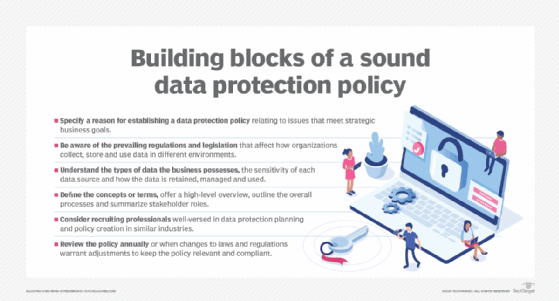Top data protection software platforms of 2025 for business
Data privacy laws, sophisticated cyberattacks and generative AI's infiltration make it imperative to invest in multifunctional data protection software, but what tools are tops?
Businesses that store and manage data need data protection software to keep their data safe and secure. But which data protection tool or platform is the best fit?
The answer, of course, depends on several factors, including the levels of data protection required, how much risk the business can tolerate and which data protection capabilities best meet the enterprise's strategy for data backup, recovery, privacy, security and compliance.
What is data protection?
Data protection is the process of mitigating the risk of data loss, compromise or corruption so that the data businesses depend on remains secure and available. Modern data protection software typically delivers a range of capabilities and features, including the following:
- Backup features make copies of production data, which a business can use to replace its data in the event that a production environment is compromised.
- Recovery tools streamline or automate the process of restoring lost data and the systems that depend on it after a data breach, corruption or loss event.
- Data discovery capabilities help locate the data businesses need to protect but might not realize exists within their large, complex IT estates.
- Database activity monitoring automatically tracks access to databases and other assets to identify anomalies that could be a sign of attempts to view, modify or delete sensitive data.
Enterprises require these core capabilities to protect their data. Some tools and platforms offer additional features.

Who offers the best data protection software?
The following list of data protection vendors and products reflects research from analyst firms regarding the largest, most innovative or most popular software. Sources include Gartner's inventory of "Enterprise Backup and Recovery Software Solutions Reviews and Ratings" and Precision Reports' "Global Data Replication and Protection Software Industry Trends Analysis Report 2024, Forecast to 2032."
To narrow the field further, we also consulted other sources to help contextualize and balance the comparisons of data protection products. For each vendor or product listed among the best data protection tools, we provide key capabilities and distinguishing features, as well as the types of data protection use cases and needs they address. Offerings are listed in alphabetical order.
Acronis
Acronis International's platform combines data protection capabilities with cybersecurity and endpoint defense features. It also offers features designed to make data protection more efficient, such as storage optimization for data backups. Acronis is most notable for its integrated approach to cybersecurity and data protection, offering an all-in-one package for data protection and cybersecurity.
Barracuda
Barracuda Networks' platform offers key data backup and recovery capabilities, providing storage efficiency and cost optimization. The platform also places special emphasis on features such as deduplication, which reduces backup storage costs and can speed recovery by removing redundant information from backups.
Cohesity
Cohesity's platform combines data management and data protection features into a single platform. It provides businesses not just data backup and recovery capabilities, but also data monitoring and replication using an integrated package of tools.
Commvault
In addition to core data backup and recovery features, Commvault's platform provides advanced capabilities like active threat scanning and cyber deception, which aims to mislead attackers in their efforts to identify where a company's sensitive or mission-critical data exists. These capabilities complement and extend beyond the basic features available from standard data protection platforms.
Dell
Dell Technologies' data protection platform primarily delivers data backup and recovery capabilities. Complementary capabilities, such as data discovery and database activity monitoring, are not a major focus. Dell's data protection features support most modern environments. It has placed particular emphasis in recent years on building out features for a href="https://www.techtarget.com/searchcloudcomputing/definition/multi-cloud-strategy">multi-cloud data backup and recovery.
Druva
Druva's data protection package is notable for its emphasis on cost optimization and efficient data recovery in addition to core capabilities such as data backup. By helping businesses determine the types of assets they need to back up cost-effectively, the platform aims to provide organizations the best balance between data protection and business cost-efficiency.
IBM
Although IBM is better known for other computer services and products, Big Blue's data protection packages are enterprise-centric and focus especially on addressing the needs of businesses with complex, sprawling IT estates, such as those that operate multi-cloud infrastructures. IBM also places special emphasis on data protection for workloads hosted on legacy platforms, such as SAP S/4HANA.
Kaseya
Although Kaseya was traditionally a vendor of monitoring solutions, it added data backup and recovery capabilities to its package of offerings. Compared with other data protection vendors, Kaseya's data protection capabilities are more limited. But the company offers a variety of other tools, such as remote monitoring and management software, that integrate with and complement its data protection products, making it an all-in-one IT management platform.
Microsoft
In addition to offering data protection capabilities that work on Microsoft's own platforms, such as the Azure cloud, the company also sells a general-purpose data protection product called Microsoft Purview, which works across most modern infrastructures or environments. Since its products are widely used across many businesses, Microsoft might be the choice of organizations looking to gain data protection capabilities without having to work with a new or unknown vendor.
Quest
Quest Software and IT software provider CDW provide data backup and recovery capabilities as part of a broad package addressing data security, data management, migration and endpoint management products. Quest's data protection features combine with its wide range of other offerings to provide comprehensive data management, security and protection capabilities.
Rubrik
Rubrik's package of data protection products places equal emphasis on backup and recovery -- not just the data that businesses store in their own applications and infrastructure, but also data housed in third-party SaaS platforms like Microsoft 365 and Google Cloud. Some competing data protection products also provide SaaS data protection capabilities, but few of them focus on that use case as extensively as Rubrik.
Veeam
Veeam Software offers a comprehensive, general-purpose data protection package that works with virtually any type of IT environment, including data assets hosted on bare-metal servers, on VMs and in the cloud. Features include instant restore, storage-based backup, whole disk and file recovery, and an AI-powered malware detection engine.
Veritas
Veritas Technologies offers data backup and recovery products for large enterprises in the form of NetBackup and for small businesses through Backup Exec. The company also provides a variety of other products related to data management and cybersecurity. Although Veritas doesn't offer truly unique data backup and recovery capabilities, additional data management and cybersecurity features cover a wide range of data protection needs.
Editor's note: This article was updated in November 2024 to improve the reader experience.
Chris Tozzi is an adjunct research adviser at IDC as well as an adviser for Fixate IO and a professor of IT and society at a polytechnic university in upstate New York.







